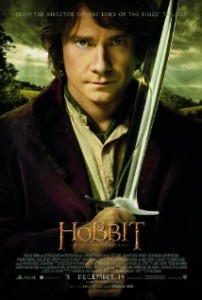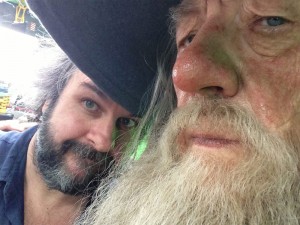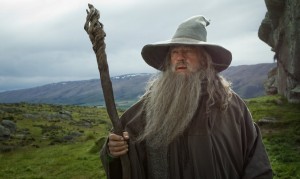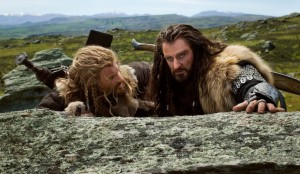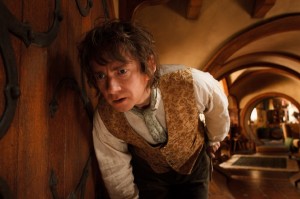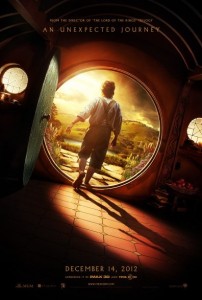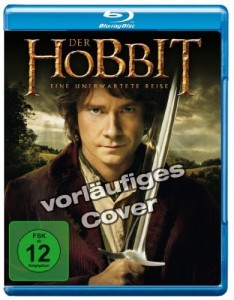The Hobbit: An Unexpected Journey *** (2012, Ian McKellen, Martin Freeman, Andy Serkis) – Movie Review
So Peter Jackson finally gets to film The Lord of the Rings sequel in 2012, after several years of pre-production hell that saw the original director Guillermo del Toro out on his ear after three years of work. A lot of fans were delighted, no doubt, and expectations were incredibly high.
First published in 1937, The Hobbit is a slimmish volume, 300 rather small pages of fairly large type, suitable for reading aloud to children, its original intended audience. I need hardly tell you that it’s a marvel of magical escapist adventure entertainment as well as being a masterpiece of English literature.
It would make, with a talent a large as Jackson’s, a perfect two-hour movie, keeping strictly to the text that, with all its dialogue and descriptions, plays a lot like a movie screenplay. You don’t have to change a thing, just perform a sweet little editing job. A perfect gig for a skilled copy editor, then.
But, and here we go, Jackson has decided to change more or less everything. He fought tooth and nail a decade ago to keep to the purity of the three-novel The Lords of the Rings as a film trilogy, even though the original studio New Line wanted a two-parter. One of the brilliant successes of The Lords of the Rings film trilogy is its careful, awe-struck adherence to Tolkien (minor tweaks excepted).
Jackson said he would never film The Hobbit, as The Lords of the Rings had exhausted him of Tolkien, taken over too many years of his life, probably in the way Star Wars has consumed George Lucas. Perhaps he felt he had to step in to save the project when the MGM studio went bankrupt a couple of years back. Maybe he’d always secretly hoped to make The Hobbit, who knows?
So, Jackson aboard, what happened next? It was announced it would be a two-parter, like the end of Harry Potter or Twilight, and then at the last minute, further news: a trilogy, just like The Lords of the Rings. How could the slim volume fill screen time for three epic movies? How indeed.
This is a massive problem Jackson doesn’t seem to have solved. This first film is just 10 minutes short of three hours, and Jackson accordingly gets along as far as about a third way in the book. Inevitably, the movie is doomed to seeming to proceed slowly and it’s padded out with flashbacks, gratuitous appearances by the Rings star cast and battle sequences to give it status and grandeur and especially links to The Lords of the Rings.
The film begins with Ian Holm as old Bilbo Baggins, writing his memoirs and then the rest is a flashback to, first of all, An Unexpected Party, where the young Bilbo is confronted at the door of his well-appointed hobbit hole by the wizard Gandalf, who tells him he’s going to send him on an adventure and is coming later for tea. Instead, at the appointed hour, bit by bit, 13 dwarfs arrive, all expecting hospitality. He’s to help them reclaim the lost Dwarf Kingdom of Erebor from the fearsome dragon Smaug. Bilbo, no hero, no burglar, no adventurer, just wants to stay home and be happy and eat. Not much of a story with plan B then…
Now, of course, the book by contrast is told in present time, and it dives right in and gets the business done. ‘In a hole in the ground there lived a hobbit.’ Not, you notice, ‘Old Bilbo, played by a different actor, was writing his memoirs for future generations to read and be inspired by and for film studios to make loadsamoney.’
It’s a tragedy that the 81-year-old Ian Holm couldn’t reprise his role as Bilbo. He’s sorely missed from the main narrative as the younger Bilbo, a loss that has salt rubbed into its wounds when Holm appears in a cameo at the start as old Bilbo only swiftly to be replaced by an uncomfortable Martin Freeman, more of a presence or personality than an actor here. Freeman certainly looks right but manages to play the role without any charisma or nuance. He has a range of only two expressions, smiling or looking worried.
But, luckily, Sir Ian McKellen is still fit and fine to return as Gandalf. Indeed, the film couldn’t have been made without him. We hope he made a fortune from this. He’s the life and soul of The Hobbit. The turn’s a trifle richer and fruitier than before, but that’s what it needs, a bit of old-style thespianning, and McKellen’s truly to be relied upon for that. Thank goodness, for Gandalf has loads to do this time and McKellen does it in style.
Unfortunately, nobody else gets a look in. Certainly not one of the 13 actors, some of them fairly famous, playing the dwarfs. They’re all covered in mounds of makeup and prosthetic. They could be anyone. Some of them might be Scottish or Australian, no idea why. None of them is able to create an interesting, true, individual character. Then again, dragging in Cate Blanchett, Elijah Wood, Christopher Lee, Hugo Weaving and the others to reprise their old world-famous roles, though enormously cheering, has the unfortunate effect of just making you wish you were watching Lord of the Rings.
Unfortunately hanging over the whole film, there’s a sense of déjà vu. Inevitably so, we’ve seen a lot of it before. At times some of it even looks like out-takes from The Rings. Ideally The Hobbit should have been filmed first, so that Andy Serkis’s Gollum would make his debut appearance, evil, scary and threatening to murder Bilbo, in the book finest sequence, an entire, marvellous chapter called Riddles in the Dark. Ah Gollum, ‘a small, slimy creature, as dark as darkness, except for two big round pale eyes like small green lamps in his thin face.’ Serkis’s Gollum isn’t like this at all, he’s much too sad and pathetic, not nearly evil, reptilian and scarily menacing enough.
There’s no sense of true danger or darkness at all in Jackson’s Riddles in the Dark set piece. He compounds this by letting all the tension dissipate by cross-cutting to find out how the dwarfs are getting on, and completely ruins the climax of the sequence by changing the ending. Can Bilbo evade both Gollum and the invading goblins and escape from the tunnel? That’s all we have to concentrate on, but somehow Jackson doesn’t want to bother.
Similarly, in the first Unexpected Party set piece, the details are pointlessly changed, reducing impact and credibility. When Jackson goes for a bit of slapstick comedy here, inspired by the knockabout in the book, he falls flat on his face. Tolkien makes it charming but Jackson doesn’t do comedy, and his film suddenly seems like a silly kids’ thing. But, later on, Jackson entirely forgets this is a children’s story, and presses the red button marked ‘Battles’, desperately seeking to engage the attention and admiration of the older, laddish Rings fans.
Not to be too unkind, but it’s not surprising that this is the first movie in Jackson’s Lord of the Rings franchise not to be nominated for the Best Picture Oscar. It’s watchable and OK but it just isn’t that good, nowhere in the league of the Rings films. It does have many virtues of course, but almost all of them are as a spectacle. Seeing it in 2D at home probably does it no favours. This is certainly one film where the 3D big-screen experience probably is needed for best effect. But wherever you see it, it looks absolutely brilliant – the scenery, sets, costumes and CGI are the best money can buy. It cost $180million, for heaven’s sake.
There was a nod to this brilliance in the Oscar nominations for Best Makeup, Production Design and Visual effects. But in the event it won no Oscars at all, though Jackson must have cried all the way to the bank when he became only the third director in movie history to make two billion-dollar-grossing films when The Hobbit nudged over the $1,000million mark worldwide.
Popular it may be, but it doesn’t have a lot of enchantment, or even much of a sense of fun or high adventure, this time round. And it’s sad to report that the film emerges as a bit of a wasted opportunity. We may give The Desolation of Smaug a try, but this time we aren’t greatly looking forward to it.
© Derek Winnert 2013 Movie Review
Check out more reviews on http://derekwinnert.com/

